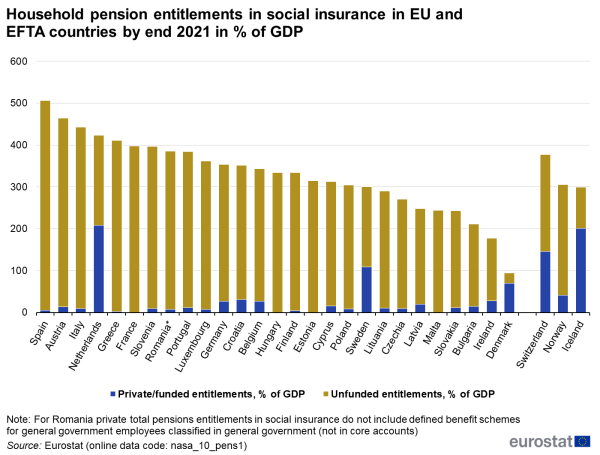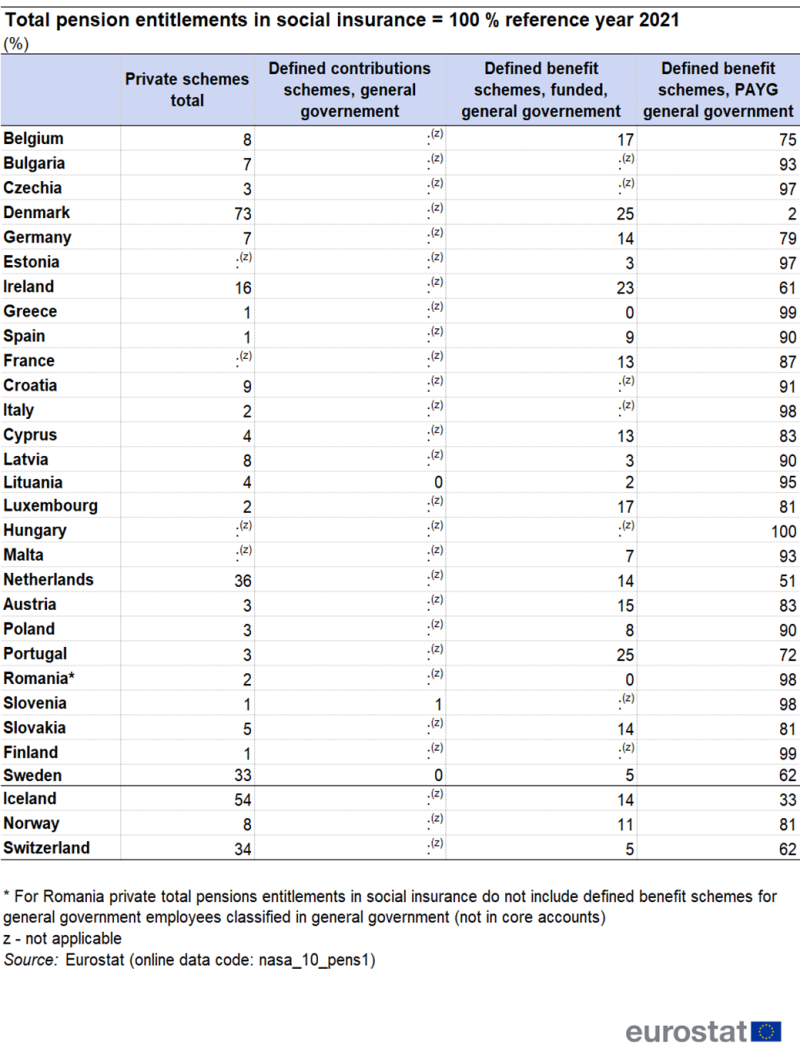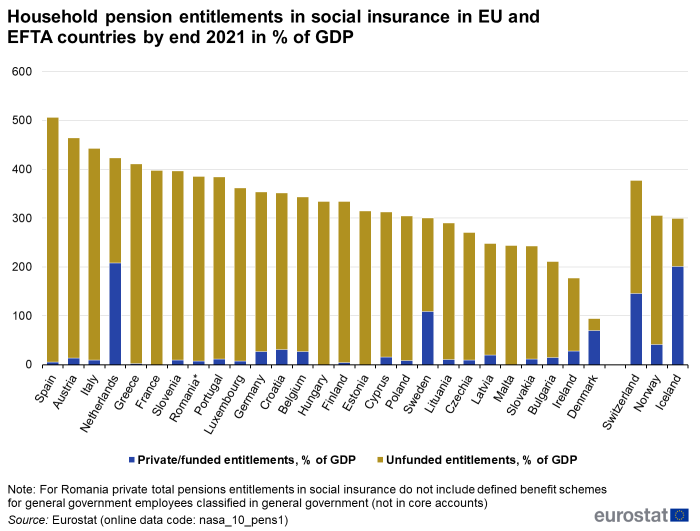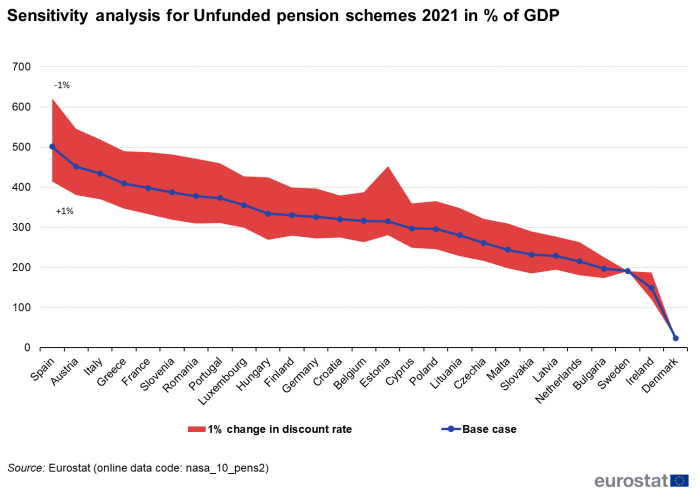Pensions in national accounts - statistics
Data extracted in February 2024
Planned article update: February 2027
Highlights
Unfunded pension schemes dominated pension entitlements of households in EU countries in 2021.
In most EU countries, the ratio of social insurance pension entitlements to GDP was between 200% and 400% in 2021.

Source: Eurostat (nasa_10_pens)
Introduction
There is high public and policy interest in how people are providing for their future retirement, and the impact that it has on their consumption and saving behaviour now. As the population ages in many European countries, and the choice of available pension schemes widens, the availability of statistics on pensions is increasingly important.
A broad range of statistics on pensions already exists, for example as part of social protection statistics. However, these are based on flows during the year – contributions and benefits paid – and not on a forward-looking basis to pensions that will be paid in the future. Eurostat, EU countries and EFTA countries are filling that gap by publishing, for the third time, a snapshot of the future pensions ("accrued entitlements") of households in pension schemes in 2021. Previous publications were done for data in 2015 and in 2018, with some countries providing also voluntary data for years in between. The data cover both private and public schemes, including social security pension schemes, which operate on a collective model (i.e. they are for a group of households, and not private individual pensions).
The statistics show heterogeneous levels of future pensions when expressed in relative terms as a percentage of a country's GDP.
Households participate in different pension schemes, whether private or public schemes. The balance across the schemes varies across the countries.
The publication of these statistics is the result of complex work done by National Statistical Institutes and Eurostat. The statistics rely on a number of assumptions about the future, in particular how to value pension entitlements in today's money ("discounting") and how long people will live in the future, and thus need to be treated carefully as estimates.
It is important to add that these statistics in themselves do not provide information about the sustainability of the pension schemes themselves and conceptually should not be linked to countries' government debt.
For funded pension schemes, sustainability depends on the performance of the investments made by the fund. For unfunded pension schemes, it depends on future contributors and future adaptations to the individual entitlements by reforms of the pension systems.
Full article
Enhanced reporting on pensions
Data on accrued-to-date pension entitlements in social insurance ("Table 29"), were introduced in the ESA 2010 transmission programme.
Reporting on pensions is multifaceted. Data on pensions in national accounts present an accounting perspective. They show social insurance pension entitlements accrued by the end of a reporting period for the current workforce and retired persons broken down by:
- type of pension scheme: defined contribution schemes and defined benefit schemes;
- institutional sector and type of pension manager: private sector and government;
- type of recording: pension schemes recorded in the national accounts framework (all funded and private unfunded employment related schemes) and pay-as-you-go (PAYG) schemes of general government (social security schemes and unfunded schemes for general government employees)[1].
- accounting category: stocks (pension entitlements at the beginning and end of a reporting period) and flows leading to changes in entitlements (payments of social contributions/ social benefits to/by the pension schemes and other changes in volume, revaluations, transfers between schemes and enacted reforms).
Enhanced pensions reporting in national accounts can serve several purposes.
It reflects the impact of social insurance systems - by different types of pension schemes - to ensure income at retirement. Social insurance systems cover employment related and social security schemes[2]. It provides a comprehensive overview of households' pension entitlements, which comprise an important part of households' wealth and is therefore relevant for an analysis of households' consumption and saving behaviour. Finally and importantly, it enhances international comparability of data on households' pension entitlements across countries by applying harmonised assumptions for recording of unfunded government pension schemes.[3]
Pension entitlements of defined benefit schemes (employment related as well as social security PAYG schemes) are the result of actuarial calculation models based on a set of assumptions reflecting expectations about future demographic and economic developments (more details are available in the section "Data sources and availability"). The presented data therefore crucially depends upon the choice of assumptions, based on the best information available at the time of data estimation. Experience shows that the estimates are particularly sensitive to the discount rate applied to calculate the present value of pension entitlements. The dataset therefore includes a sensitivity analysis for PAYG pension schemes where no entitlements are recorded in the existing national accounts framework, showing to what extent the value of pension entitlements may change if the discount rate is higher or lower. The accrued-to-date pension entitlements in social insurance are NOT suitable as a measure of the sustainability of pension schemes and should not be considered part of government debt. Sustainability analysis of pension schemes requires different, more forward-looking calculation approaches, notably considering future flows of social contributions. More details on complementary reporting on pensions are given in the section "Context" below.
Background
The background to "ESA Table 29" on accrued-to-date pension entitlements in social insurance
The worldwide agreed standards for national accounts are the System of National Accounts (SNA). The European System of Accounts (ESA) is derived from, and consistent with, the SNA. During the last revision of the SNA, it was recognised that more information should be included on pensions. The resulting SNA (SNA 2008) included the entitlements of all private pension schemes and funded government schemes as assets (of households) and liabilities (of pension schemes). This is technically referred to as recording in the "core" accounts, because these are the standard accounts to be presented to users. The SNA 2008 allowed flexibility for recording of the entitlements of unfunded government employer pension schemes. Some non-European countries decided to include the entitlements as liabilities (i.e. in the core accounts), however in the EU it was decided that these entitlements would not be recorded as liabilities. In order to allow data users to compare the data between countries, which had adopted different recording approaches, it was agreed that a "supplementary table" showing the entitlements of all social insurance pensions (including those of social security schemes) would be prepared. In the EU, this table is reported on a compulsory basis to Eurostat as "Table 29" of the ESA 2010 Transmission Programme. The OECD is collecting such a table on a voluntary basis from non-European countries and publishes it on their website.
Main statistical findings
The presented analysis is based on data in percentage of GDP for the reference year 2021.
Households pension entitlements in social insurance in EU and euro area
The main value added of the data collection on pensions in national accounts is a comprehensive coverage of all types of pension schemes in social insurance, i.e. not only employment related private/funded schemes (entitlements of which are already recorded in main national accounts tables), but also PAYG schemes managed by general government. Most prominent of the latter is social security pension insurance.
Main findings among EU and EFTA countries
Comprehensive coverage of social insurance pension schemes in a single dataset enhances cross-country data comparability of household pension entitlements, since the importance of occupational private/funded pension schemes as compared with the social security can vary greatly from country to country.
Table 1[4] presents total pension entitlements at the end of 2021 in social insurance schemes in EU and EFTA countries broken down by sector and by type of pension scheme as percentage of the total, to show the relative importance of different types of pension arrangements in each country.

Source: Eurostat (nasa_10_pens)
In a number of countries social pensions insurance is provided almost entirely by the social security system where it generates at least 90% of total social pension entitlements. This group includes 14[5] out of 27 EU countries (see Table 1). Among EFTA countries this is not the case.
On the other hand, some countries have established a well-developed system of private occupational pension insurance where employers provide pension schemes for the benefit of their employees, and employees can also additionally contribute to such schemes. In four out of 27 EU countries private occupational pension insurance generates over 10% of total social pension entitlements: see Table 1. Among EFTA countries private occupational insurance is also significant in Iceland and Switzerland.
Figure 1 and Table 2 present total household pension entitlements in social insurance accrued by the end of 2021 in EU and EFTA countries in billions of euro and as a percentage of GDP[6], broken down by private/funded schemes (whose entitlements are already recorded in published national accounts data) and PAYG or not funded schemes whose entitlements that are considered as contingent (recorded only in the dedicated table on accrued-to-date pension entitlements in social insurance).

Source: Eurostat (nasa_10_pens)
The highest ratio of social insurance pension entitlements to GDP of 507% is recorded in Spain. Austria, Italy, Netherlands and Greece also had pension entitlements above 400% of their GDP. In 20 countries, the ratio of social insurance pension entitlements to GDP falls into the range 200% – 400% of their annual GDP, and this is also the case for all three EFTA countries. The ratio of social insurance pension entitlements to GDP is below 200% in Ireland and Denmark. The lowest ratio is observed for Denmark, which records a very limited number of unfunded pension schemes in social insurance due to its specific arrangement of pension provision. The EU countries with over a 30% share of private/funded pension schemes are Denmark, Croatia, Netherlands and Sweden, and this is also the case for Iceland, Norway and Switzerland.
Results of sensitivity analysis for the PAYG schemes
The analysis above demonstrated that the highest share of Households' pension entitlements in most countries accrues in defined benefit pension schemes (both funded and PAYG regimes). As explained in the next section, recorded pension entitlements of defined benefit schemes are equal to amounts due to be paid in retirement to past and present employed persons, projected by actuarial methods and then discounted to present value. Thus, the recorded level of pension entitlements is significantly influenced by the choice of the discount rate. Therefore, sensitivity analysis with respect to the choice of the discount rate for PAYG pension scheme entitlements has been performed to show the effects on changes in the discount rate on published figures. In the base scenario, the discount rate used for PAYG schemes calculations is aligned with the overall assumptions being used by EU's Ageing Working Group: 2% real, 4% nominal[7] (more details are available in the next section).
Whilst a common discount rate is used for the modelling of PAYG schemes, the source data used by statisticians for private pension schemes may be based on different discount rates, which are often lower. This means that the entitlements for these schemes could be recorded as higher than if the common discount rate assumption was used.
Sensitivity analysis of Unfunded pension schemes 2021 in % of GDP

Source: Eurostat (nasa_10_pens)
Figure 2 shows the impact of the sensitivity analysis per country, changing the discount rate by +1% and -1% for pay as you go schemes. Overall, it can change total entitlements for most of the countries by around 20% of GDP, with a lower discount rate increasing entitlements above base case scenario, and with higher discount rate decreasing the entitlements. For the pension systems of Sweden[8] and Denmark[9] a sensitivity analysis on the discount rate is not appropriate.
Source data for tables and graphs
Data sources
Data on accrued-to-date pension entitlements in social insurance are currently available for almost all countries for the reference years 2015, 2018 and 2021, which are the legal requirement under the ESA 2010 transmission programme. However, some countries may choose to provide data for more reference years on a voluntary basis. The assumptions may change over time and therefore it is not appropriate to look at these data as a time series, but rather as snapshots at particular points in time. National data sources and methods to calculate accrued-to-date pension entitlements are described in pension fact sheets for each type of scheme and sector. Data sources and calculation methods differ for defined contribution and defined benefit pension schemes.
Defined contribution scheme: benefits are defined exclusively in terms of funds built up from the contributions made over the employee's working life and the increases in value that result from the investment of such funds by the manager of the pension scheme. The entire risk to provide an adequate income in retirement is borne by the employee. Providing data on defined contribution schemes is straightforward based on pension funds' financial statements. Defined benefit scheme: benefits payable to the employee on retirement are determined in advanced by the use of a formula (e.g. related to salary and years of service), either alone or in combination with a guaranteed minimum amount payable. The risk to provide an adequate income in retirement is borne by the employer or a unit acting on his/her behalf. For the purposes of statistical recording, so-called "hybrid" schemes (which have features of both defined benefit and defined contribution schemes) are included as defined benefit schemes. Defined benefit scheme can be funded (e.g. most private pension schemes) holding assets to meet their liabilities or unfunded functioning on pay-as-you-go (PAYG) basis (e.g. social security schemes). In PAYG schemes benefits payable in current period are financed by the social contributions receivable in the same period. There is no saving element involved in such schemes. At the end of an accounting period, the level of pension entitlements due to past and present employees is calculated by estimating the present value of the amounts due to be paid in retirement using actuarial calculations. There is a considerable delay between a reporting period when rights to defined benefits were earned and the actual payment of benefits in the future at retirement. The amounts to be paid, their timing and duration are not certain, but dependent upon the beneficiary. Actuarial calculations are therefore necessary to:
- project when and how long benefit payments are to be made (demographic projection)
- project the level of benefits to be paid (economic projection)
These projections are based on assumptions about future events. Key assumptions to measure pension entitlements are:
- economic (discount rate to estimate present value of pension entitlements, inflation, wage growth, unemployment rates)
- demographic (life expectancy, fertility rate, migration, prevalence of disability)
Changes in actuarial assumptions may occur from period to period as new information on demographic and economic events becomes available, and will result in changes in the level of calculated pension entitlements. These are recorded in national accounts as "Other changes due to revaluation", reflecting changes in economic assumptions, and/or "Other changes in volume" reflecting changes in demographic assumptions. The employer and/or employee may make actual contributions to the defined benefit scheme in the current period. In case if such payments were insufficient to meet the increase in the benefits accruing from the current year's employment, an additional contribution from the employer is imputed to bring equality between total contributions and the increase in current service entitlements. Such imputed contributions are usually positive but it is possible for them to be negative if the sum of the actual contributions received exceeds the increase in current service entitlements. It should be noted that no employer contributions are imputed for multi-employer schemes. For employment related private/ funded defined benefit schemes whose entitlements are recorded in main national accounts framework, the main data sources are financial statements and reports compiled on the basis of international and national accounting standards, often collected by national pension regulatory authorities. Actuarial assumptions are defined by pension managers, usually following the recommendations of national pension regulatory authorities, and therefore the applied discount rate may vary between countries and schemes. For PAYG defined benefit schemes whose entitlements are not recorded in main national accounts framework, information on actual social contributions and benefits payable come from annual government finance data. Actuarial calculations of pension entitlements are performed by national statistical institutes or public pension authorities based on assumptions harmonised across EU Member States to ensure cross country comparability. See The 2021 Ageing Report: Underlying Assumptions and Projection Methodologies Part I Chapter 1 for more details on pension schemes and choice of the discount rate. For the demographic assumptions, population data published by Eurostat should be used by countries. More information on actuarial calculation methods and assumptions, as well as available data sources, used to calculate pension entitlements in national accounts is available in the Technical Compilation Guide for Pension Data in National Accounts.
Context
Different pension calculation approaches serve different analytical purposes. Data on pensions in national accounts present the accounting perspective (accrued-to-date entitlements) as explained in the first part of this article. Data on pensions in national accounts are not suitable for assessment of the sustainability of pension schemes. They can be interpreted as the amount of pension rights which have been accumulated up to a given year based on previous contributions (and therefore the entitlements which households would receive if the schemes closed at that point). Entitlements that will accrue after that year are not included. A large level of accrued pension entitlements does not necessarily mean that pension schemes are unsustainable, and conversely a small level of accrued pension entitlements does not mean that the respective pension schemes are sustainable. Sustainability of a pension schemes depends on the respective evolution of pension benefits and contributions over many future years.
Thus, for the assessment of pension system sustainability, a different calculation approach based on an "open system" is necessary. Unlike the pensions data in national accounts presented here that cover only entitlements accrued to a given date for the current and past workforce, open system estimates include future entitlements to be accrued over the rest of the career of current workforce and future entitlements of people who are not yet working today. The assessment of sustainability also takes into account future contributions. At European level, the projected impact of pension systems on public finances was addressed in The 2024 Ageing Report and Fiscal Sustainability Report 2021 prepared by European Commission Directorate General on Economic and Financial Affairs. A further report will be published in 2024.
Accrued-to-date pension entitlements in PAYG schemes whose entitlements are not recorded in main national accounts framework (e.g. social security scheme) should not be interpreted as part of government debt. In PAYG pension schemes managed by general government, benefits payable in current period are financed by the social contributions receivable in the same period. Moreover, where such contributions fall short of current year benefits liabilities, government have the power, through reform of the pension schemes, to change not only the path of pension entitlements related to future employment but also entitlements relating to past employment. For this reason, the entitlements for these schemes are not recorded as liabilities in national accounts, but are considered as having a contingent status.
Direct access to
See also
Database
- Accrued-to-date pension entitlements in social insurance (nasa_10_pens1)
- Sensitivity analysis of accrued-to-date pension entitlements in pay-as-you-go pension schemes (nasa_10_pens2)
Dedicated section
Publications
Methodology
Notes
- ↑ Some pension schemes are already recorded in existing, published national accounts datasets. It distinguishes them from PAYG schemes that are considered as contingent in nature and are not recorded in main national accounts framework. All entitlements for the PAYG schemes should be considered as contingent entitlements.
- ↑ Individual pension plans, where policies are taken purely by individual initiative of a policyholder without intervention of a third party (employer or government), are treated as life insurance in national accounts and therefore excluded from the pension table.
- ↑ The importance of social security schemes for securing retirement income as compared with private employment related plans varies significantly from country to country and information on the entitlements accrued under social security schemes is available for the first time with the introduction of ESA 2010 and reporting on pensions in ESA 2010 data transmission programme.
- ↑ For Romania private total pensions entitlements in social insurance do not include defined benefit schemes for general government employees classified in general government (not in core accounts).
- ↑ For Romania private total pensions entitlements in social insurance do not include defined benefit schemes for general government employees classified in general government (not in core accounts).
- ↑ 2021 GDP was impacted by COVID-19, more information on GDP in current prices is available here: https://ec.europa.eu/eurostat/databrowser/bookmark/9e629732-0d0b-42cc-be18-2c9420b335d5?lang=en .
- ↑ Except Sweden which has unique pensions system.
- ↑ Sweden: only small part of the scheme is dependent on discounting, change of +/-1% in discount rate would cause +/-2% of entitlements due to the fact that the active population earning pensions is very close to retirement.
- ↑ Denmark: early-retirement scheme has a very short time horizon of only 3 years, therefore estimate is not discounted.
